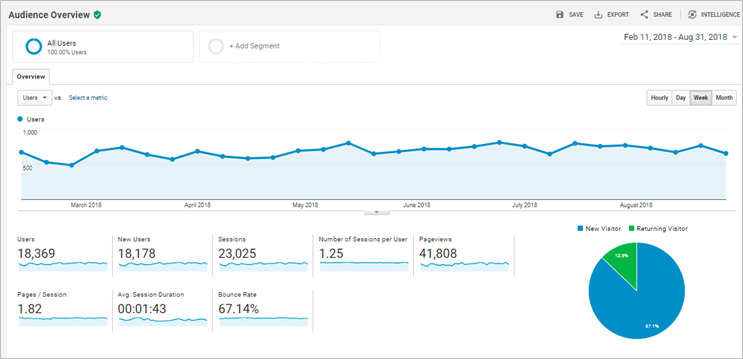The Complete SEO Checklist for New Website in 2018

Search Engine Optimization (SEO) is among the most critical processes to rank any website on SERP. If you are looking for an SEO checklist to follow and optimise your website for Google or any search engine, then this is where your search ends.
In the coming weeks, we will provide an extensive guide for the below mentioned SEO checklist that you should follow when performing an SEO Audit.
- Keyword Research Checklist
- Technical Analysis Checklist
- On-Page SEO Checklist
- Competitive Analysis Checklist
Before moving to the checklist, you should complete the following tasks on your website:
- Setup Google Search Console – This should be the first task on your list, especially for an entirely new website.
Google Search Console provides data on a website’s performance in search results. Below are the most useful features you can use in Google Search Console:
- Keywords (Branded & Non-Branded) that are getting the most traffic
- The average keyword position in Google Search
- Submitting a sitemap
- Fixing errors on a website
Receiving messages from the Google Search team, if your website has any error(s) and more.
- Setup Google Analytics Account – This is where you will find detailed information about the users who are visiting your website. It will show where the users are coming from.
Google Analytics has many useful insights related to your website traffic and how users find and use your website. Some of the useful features are:
- Total number of users (traffic) are coming to the website
- The number of users coming to your website using Search Engines (Organic Traffic)
- The landing pages on the website getting most of the traffic
- Website’s average bounce rate
- Website traffic – is it increasing or decreasing?
- Track how many users are submitting a query through your ‘contact us’ form
- Which websites or, search engines are getting you the most traffic?
So, once you are done with these two steps, it is the time to focus on our main SEO Checklist.
Keyword Research Checklist
Keyword research is the most important part of Search Engine Optimization and should be on the top of your to-do list. You cannot do much without a thorough ‘keyword research’ for your website. Through this process, you will find your target audience, learn the topics, and keywords and phrases your audience will use to find your website. So, in this checklist, we will guide you through the process on ‘how-to find most relevant keywords,’ for your website and what kind of keyword search tools you can use to do the keyword research.
Technical Analysis Checklist
Technical SEO is a highly important part of the complete SEO process. If it is not properly implemented, it will easily break your website. However, the best part is that it is not as hard as it sounds. Below are some points that we’ll cover in our technical analysis checklist:
- Canonical Issue – Canonical URLs are those URLs which have the same content, but the URL is different. We use the canonical tag to avoid issues with duplicate content.
- XML Sitemap – XML sitemap is an .xml file that has all the pages of your website. Search engines like Google can use the XML sitemap as a guide when crawling your website.
- URL Structure – Defining a user and search engine friendly directory structure is among the best practices for SEO. It helps the website and improves user navigation. It is important to note that the website is crawled and indexed by search engines. To solve this, it is necessary to optimize meta codes, fix CSS issues and JavaScript.
- Site Errors – Check your website’s health using tools like Google Webmasters and Bing Webmasters to fix crawl errors such as 4xx and 5xx errors, inaccessible pages in the XML sitemap, and soft 404 errors.
- SSL & HTTPS – According to the new Google update, HTTPS is a now one of the ranking factors. Previously, it was only significant for eCommerce websites, but now it is essential for all websites present on the internet.
- Pagination – Logically connect content on multiple pages using Pagination, improve crawl depth and fix duplicate content issues.
- Site Speed – Good site speed offers a better User Experience (UX) and conversions. It is necessary to optimise website speed across different platforms, e. desktop and mobile. The process includes optimization of JS, CSS with making sure the user experience is good.
- Mobile Friendly – Optimizing your website for smartphone crawlers and prioritise user experience for better SEO results. Strategy and execution include – the creation of mobile-friendly URLs, site structure, and fixing faulty redirects.
On-Page SEO Checklist
Once you are done with the technical part, the next most important part is optimising your website’s On-Page SEO. In this checklist we will cover the following points:
- SEO Friendly URLs – It helps search engines to know what your page is all about. That is why it is important to add our main keywords in the URL.
- Meta Title – The page title is one of the most critical factors that help in getting a page ranked on a search engine. Your website needs to have a unique title tag for each page with the targeted keywords.
- Meta Description – Like the title tag, all your website pages need to have a unique and relevant meta description.
- Header Tag – Optimize each page’s heading tags like H1, H2 and more to direct Google crawlers in identifying the theme of a page and help that page rank better.
- Duplicate & Hidden Content – It is necessary to fix issues like multiple URLs that point to the same Not following this practice dilutes the page authority and also creates duplicate content issues. Furthermore, analysing the HTML code of all pages to check content crawled by search engine bots is the same.
- Image Alt Tag – All images on your website should have alt text. It helps search engines to understand what an image is about.
- Structured Data – Though it is not as crucial as points mentioned above, schema markup gives search engines a better understanding of the segment and category of your subject matter.
Competitive Analysis Checklist
In this analysis, you will get a better understanding of your competitors and where they stand to help you define your goals. In this analysis, we will cover the below-mentioned points:
- Identify your competitors – The first step is to find out your top 4-5 competitors. SEMrush, MOZ, SimilarWeb, Ahrefs are some of the top SEO tools that can help find competitors who are strong in organic searches.
- Competitor’s Backlink Gap Analysis – You’ll get to know from where your competitors are getting backlinks, are they coming from high authority sites? Once it is analyzed, you can build your website’s backlink basis those sites.
- Keyword Gap – By doing a keyword gap analysis, you will get to know the keywords your competitors are ranking on. It will also show the keywords where you are failing.
- Content Gap Analysis – This is where you’ll find if your competitors have any specific landing pages which your website doesn’t, and if there is any opportunity to create these landing pages for your website to target new keywords
Conclusion: By following this step-by-step SEO checklist right, you will witness improvement to your website’s traffic. Do let us know in the comments section if you want to know anything more specific about SEO.


